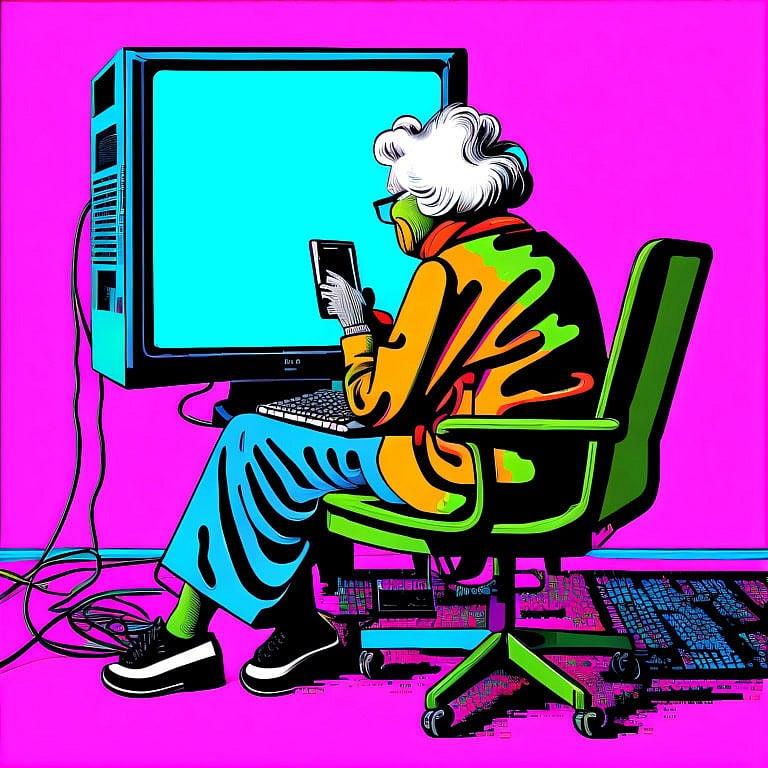Robots will help cure loneliness
Social companions can read emotions and help with daily tasks

This illustration was created by Maclean’s art director Anna Minzhulina using the generative AI image program Imagine. Minzhulina spent weeks feeding prompts into the program, inspired by the essay.
Share
Amir Shabani is an assistant professor of computing at the University of the Fraser Valley.

Canada is facing an epidemic of loneliness—a crisis that the COVID-19 pandemic only exacerbated. As seniors and young adults found themselves cut off from vital sources of communication during lockdown, they reported elevated levels of isolation. One solution might come in the form of a social companion robot. I’m building it right now.
I lead an AI team on a project run by the University of the Fraser Valley’s Community Health and Social Innovation Hub to reduce loneliness in adults. With a group of six researchers, we work on human-in-the-loop affective computing software, or emotional AI, that can recognize, process and simulate human feelings. We’ll deploy this software in prebuilt robots—right now, we’re working with one that’s roughly the size of a three-year-old child and another that looks like a cross between a bunny and a puppy. We’re focusing on engineering the privacy, security and safety in design, and we aim to get the first versions of our products on the market in the next two years.
Our aim is to maximize the user’s sense of independence while also providing social companionship. This type of technology can revolutionize how seniors live their day-to-day lives. Our robot has a variety of practical functions: if users have smart home devices, our robot can connect to them to control the blinds, turn on lights and contact authorities during medical emergencies. Picture this: an elderly woman is living alone, and she doesn’t know the kitchen floor is wet from a spill. If she slips and falls, she might not be able to get up to call for help. Our social companion robot could intervene at two stages: first, it could detect the spill and alert the user, preventing the fall completely. Second, if the woman slips, the robot could call an ambulance for support and provide comfort while she waits.
MORE: The future of AI—and Canada’s place in it
Our robots will be outfitted with cameras, microphones, speakers, touch sensors (for users who want to pat the robot) and haptic sensors (so the robot can respond with touch, if the user wants). To teach our robot how to detect emotions, we have trained it on publicly available datasets that show a range of emotions on the faces of people across different ages, races and genders. The goal is for our robots to be personalized companions that can fine-tune conversations with users and even help them regulate their emotions—whether they’re depressed, anxious or angry. If the machine recognizes that the person is sad, it could redirect the conversation and eventually guide them to topics that make them happier.
Future social companion bots may have different goals. Given the progress we have made with natural language processing, I envision a massive upgrade to virtual assistants like Alexa and Siri. Right now, if you talk to them, they’re useless after a few rounds of conversation. That’s because they’re tailored to the company’s interests and trained to direct you to certain services, push music or sell products. But, with the advancement in large language models such as ChatGPT, I think we will see more human-level soft skills integrated in the bots. This means giant tech companies such as Google, Apple, and Amazon could leverage those and make Siri and Alexa understand conversations better—the context, the scenario—so these virtual assistants can provide more social companionship than ever before.
Of course, there’s always an ulterior motive. For some companies, increased engagement and dependency on their technology opens the door for them to get into our minds, which provide a different type of data they can capitalize on. It could help them better tailor advertisements or push their sales agenda. At the end of the day, these kinds of assistants will always be biased toward business.
MORE: AI avatars will be the new customer service reps
I believe profit-seeking businesses may also try to gain an edge in the social companionship robot market. Major companies like Rogers and Telus, which already offer smart home devices and applications, will snap up smaller AI companies that build social companion robots and sell these machines. This comes with a number of practical advantages. Telus already has senior-friendly tech, like wristbands and necklaces that people can press if they’ve fallen and need assistance, and these robots can be a new product in their arsenal. Personalized robots can also connect with existing smart home technology from these companies, integrating all the tech in one machine. Most importantly, if big companies start selling these products, they can cut down the cost factor for users. Smaller AI companies simply don’t have the resources and capacity to sell social companion robots at a cheaper price, which is a significant barrier for users. Human contact and conversations with loved ones will never be supplanted by technology, but these machines can help shift the tidal wave of loneliness back to a more connected, happier and healthier society.
We reached out to Canada’s top AI thinkers in fields like ethics, health and computer science and asked them to predict where AI will take us in the coming years, for better or worse. The results may sound like science fiction—but they’re coming at you sooner than you think. To stay ahead of it all, read the other essays that make up our AI cover story, which was published in the November 2023 issue of Maclean’s. Subscribe now.